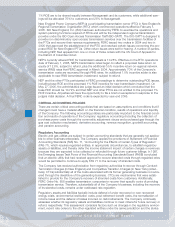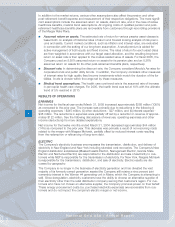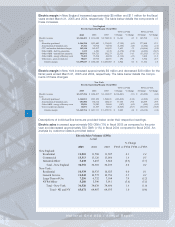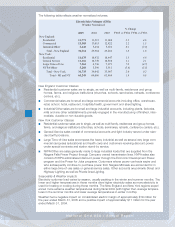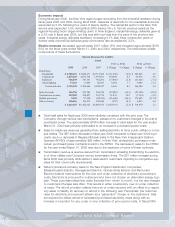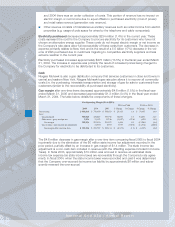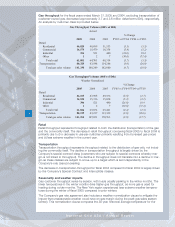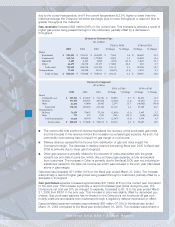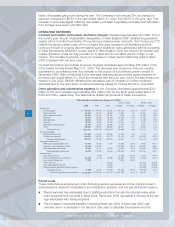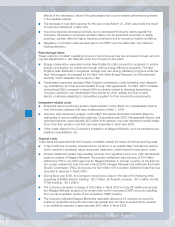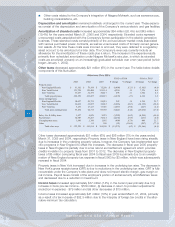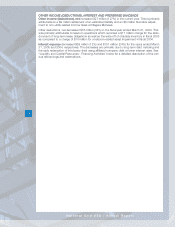National Grid 2005 Annual Report Download - page 17
Download and view the complete annual report
Please find page 17 of the 2005 National Grid annual report below. You can navigate through the pages in the report by either clicking on the pages listed below, or by using the keyword search tool below to find specific information within the annual report.
effects of the decreased value of the plan assets due to poor market performance (primarily
in the equities market).
■The decrease in bad debt expense for the year ended March 31, 2005 was mainly the result
of improved collections in New York.
■Insurance expense decreased primarily due to decreased third-party claims against the
Company, decreases in employee accident claims and an expanded emphasis on safety
practices, partially offset by higher insurance premiums due to insurance market conditions.
■Regulatory commission fees are fees paid to the FERC and the state utility commissions
having jurisdiction.
Pass-through items
These costs do not affect operating income or net income as they are recovered through reconcil-
ing rate adjustments or are deferred under the Company’s rate plans.
■Energy conservation expenses include New England’s costs incurred for programs to reduce
energy consumption by customers through various energy efficiency programs. The New
England retail distribution companies manage their own energy efficiency programs while the
New York program is managed by the New York State Energy Research and Development
Authority which assesses the Company a fee.
■Transmission expenses represent New England transmission costs (wheeling, load dispatch-
ing, substations, etc) that are recoverable through rate agreements. The $22 million increase
during fiscal 2005 compared to fiscal 2004 is primarily related to wheeling (transmitting
Company electricity over transmission lines owned by other utilities) and due to retail
electric customers migrating to competitive suppliers for their commodity requirements.
Integration-related costs
■Enterprise resource planning system implementation costs reflect non-capitalizable costs for
new information systems that were implemented on May 1, 2004.
■Voluntary early retirement program costs reflect the special termination benefits offered to
employees to reduce staffing redundancies. During fiscal year 2005, Narragansett Electric was
permitted recovery approximately $23 million of its pension and post retirement benefit obliga-
tions other than pension cost that had been expensed in fiscal year 2004.
■Other costs related to the Company’s integration of Niagara Mohawk, such as severance pay,
building consolidations, etc.
Atypical costs
These items are expenses that the Company considers outside the scope of normal recurring costs.
■In April 2003 the Company experienced an ice storm in its upstate New York service territory
which resulted in excessive repair and power restoration costs beyond normal storm costs.
■Pension settlement losses have resulted primarily from significant lump-sum cash withdrawals
made by retirees of Niagara Mohawk. The pension settlement loss recovery of $14 million
reflects the PSC’s July 2004 approval for Niagara Mohawk to recover a portion of the $30 mil-
lion pension settlement loss incurred in fiscal 2003. Niagara Mohawk has petitioned the Public
Service Commission (PSC) for recovery for $21 million of the pension settlement loss that was
recorded to expense in fiscal 2004.
■During fiscal year 2005, the Company recognized a loss on the sale of the following three
properties (i) Buffalo Electric building - $3.5 million, (ii) Towpath property - $0.5 million and (iii)
O’Neil building - $3.2 million.
■The Company recorded a charge of $19 million in fiscal 2003 to write off certain pre-acquisi-
tion Niagara Mohawk projects in its construction work-in-process (CWIP) accounts resulting
from a post-acquisition review of pre-acquisition CWIP projects.
■The Company adjusted Niagara Mohawk’s estimated allowance for doubtful accounts for
customer receivable accounts with balances greater than 90 days in arrears which resulted
in an additional expense of approximately $42 million in fiscal 2003.
17
National Grid USA / Annual Report


